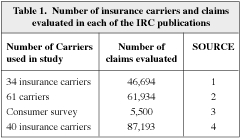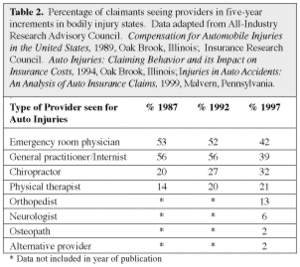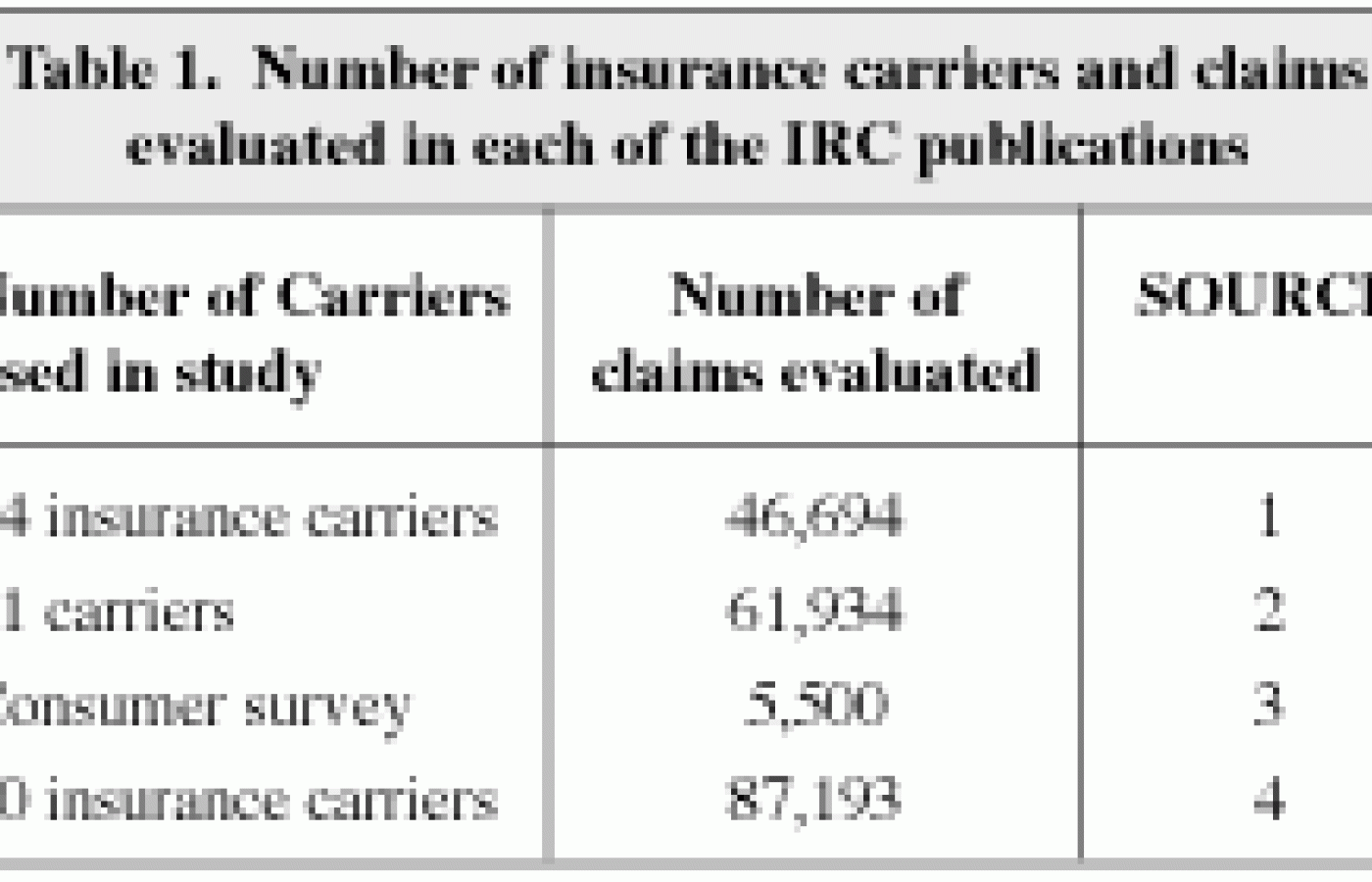Back pain? Blame the psoas. Seems as if everybody wants to dive headfirst into their psoas at the first sign of trouble with the lumbopelvic-hip region. Perhaps no other muscle is blamed more for causing problems than the psoas. Yes, it is an important stabilizer of the lumbar spine, but it shouldn't be the only one on which you focus. There is another big player on the scene: the iliacus.
How Have Chiropractors Fared in Recent Years with Whiplash Cases?
Chiropractors have been actively treating whiplash soft-tissue injuries for decades. This article explores how the chiropractic profession has fared in recent years compared to medical doctors and physical therapists. These comparisons will illustrate the percentage of claimants seeing the various providers in five-year increments. This paper shows that the chiropractic profession continues to have a healthy upward growth trend, whereas the number of claimants seeing MDs and PTs has declined or has had little growth in recent years.
There are several situations in which knowing how the profession is doing can be useful to the chiropractor. This is particularly true when a chiropractor is determining what fees to charge for services, and when looking at one's practice profile and comparing it to averages in the community. It is also true when responding to a case reviewer or another doctor who has reviewed your file and determined treatment necessity, and in a deposition or trial environment in which the defense expert gives his or her opinion with regard to the reasonableness of the treatment given by the chiropractor in a specific whiplash case.
Table 1. Number of insurance carriers and claims evaluated in each of the IRC publications

This paper will review data published by the Insurance Research Council (IRC), an independent nonprofit research organization whose funding is obtained from insurance carriers in America. The IRC's staff collects auto injury claim information from the larger insurance carriers in the United States and from a consumer survey it conducted. (See Table 1 for the number of claims that were evaluated). The IRC evaluates claim data from all fifty states. There have been four IRC publications that have looked at the chiropractic, physical therapy, and medical professions.
In 1997, the IRC shows that in bodily injury states, about 42% of all claimants went to an emergency room, down 21% from 1987. There was a 30% decline in the number of claimants seeing general practitioners or internists. Physical therapists have had a 50% increase in the number of cases in the past 10 years, yet, the majority of that gain occurred before 1992, with only a 5% gain seen in the past five years. Chiropractors have had a 40% gain over the past 10 years the most overall gain in total numbers of claimants seen for any type of provider. Table 2 covers trend data 1987 to 1997 in bodily injury states.
Nordhoff and Banerjee5 found in their analysis of 300 chiropractors surveyed about their practice perceptions that the median total number of office visits for an uncomplicated case was 21 visits, compared to 28 visits for the more complicated case. This data is consistent with data published in the IRC literature.
In the 1999 IRC publication,4 claim data from 1997 was analyzed for the average number of office visits by the type of provider. When looking at the chiropractic profession the IRC found that in bodily injury states the:
- 25th percentile DC will average 11 visits;
- 50th percentile DC will average 20 visits; and
- 75th percentile DC will average 32 visits.

Table 2. Percentage of claimants seeing providers in five-year increments in bodily injury states. Data adapted from All-Industry Research Advisory Council. Compensation for Automobile Injuries in the United States, 1989, Oak Brook, Illinois; Insurance Research Council. Auto Injuries: Claiming Behavior and its Impact on Insurance Costs, 1994, Oak Brook, Illinois; Injuries in Auto Accidents: An Analysis of Auto Insurance Claims, 1999, Malvern, Pennsylvania.
How much does the average DC charge for an office visit in the United States for automobile crash injuries? With the average claimant seeing a chiropractor for 24 office visits for an average cost of $2,235 in 1997,4 it is possible to calculate a rough estimate of the cost for a typical visit after deducting for the expenses for initial examination, diagnostic procedures, and re-examinations. The average $2,235 payment per claimant includes all diagnostic and treatment costs associated with the chiropractor. If the $400 for nontreatment expenses is deducted from $2,235, and the remaining $1,835 by 24 visits, the average fee would roughly be $76 per visit in 1997 monetary value. When contrasting the MD and PT combined profile, which is the equivalent in most cases to the DC who manages a claimant by himself for soft tissue injuries, the average payment for the MD/PT combined case is somewhere between $1,853 and $2,521. The MD/PT figures do not account for cases in which the MD did not refer to PT. Based on these figures, there is not a significant difference between the sole DC and the MD/PT combined management costs. These figures are not absolute guidelines for any provider.
The IRC figures are averages and a median figure would be more accurate. In addition, the average cost does not account for injury severity or any complicating factors in claimants.
In summary, this review of IRC data clearly shows that the chiropractic profession continues to have substantial growth in the personal injury field, whereas claimants seeing MD/PT providers have declined or have remained rather stationary. In states that have bodily injury coverage, the IRC found that 33% of the total aggregate payment to all providers by the carriers went to chiropractors.4 My only caution with this good news is that the chiropractic profession is going to undergo more scrutiny in the future, as the IRC data is reviewed by all of the leading insurance carriers. For the profession to continue to prosper, it is important that chiropractors continue to focus on getting good results, obtain excellent patient satisfaction, keep costs competitive, and maintain good management ethics.
References
- Compensation for Automobile Injuries in the United States, 1989. All-Industry Research Advisory Council, Oak Brook, Illinois.
- Auto Injuries: Claiming Behavior and its Impact on Insurance Costs, 1994. Insurance Research Council Oak Brook, Illinois.
- Paying for Auto Injuries: A Consumer Panel Survey of Auto Accident Victims, 1994. Insurance Research Council, Oak Brook, Illinois.
- Injuries in Auto Accidents: An Analysis of Auto Insurance Claims, 1999. Malvern, Pennsylvania.
- Nordhoff LS, Banerjee R. Chiropractic Perception of Treatment Frequencies, Duration, and Therapy Types: A Survey of Whiplash Treatment. Pending publication.



